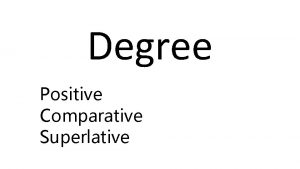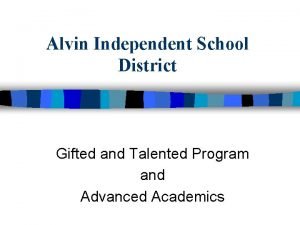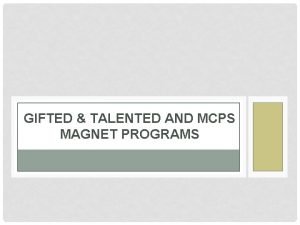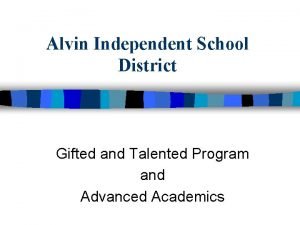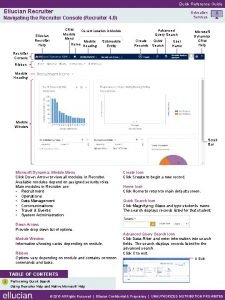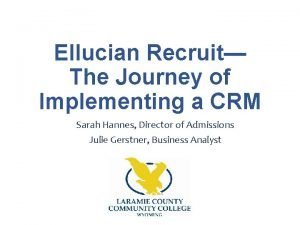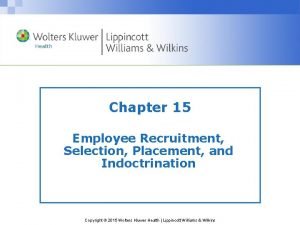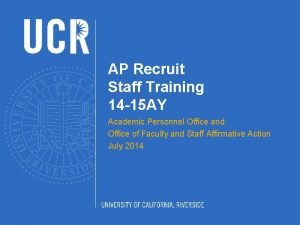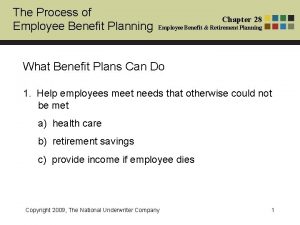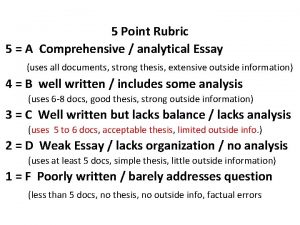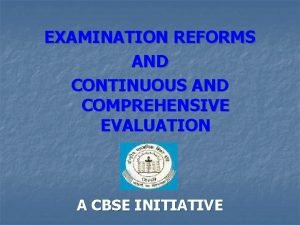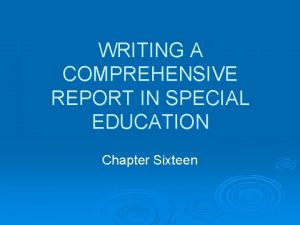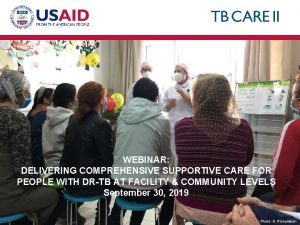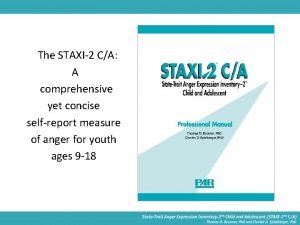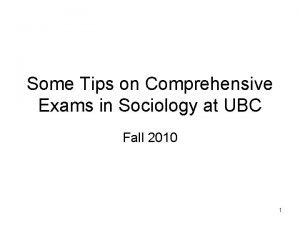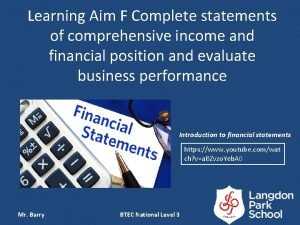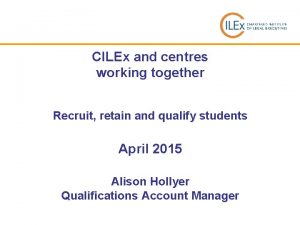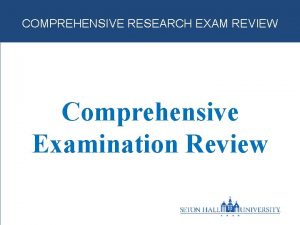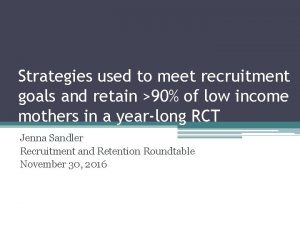Comprehensive Strategies to Retain Recruit and Support Talented

























































- Slides: 57

Comprehensive Strategies to Retain, Recruit, and Support Talented Teachers Presentation to the Virginia Board of Education Elizabeth Eaton Aracelis Gray January 23, 2019 www. arccta. org * info@arccta. org 1

About the ARCC • The ARCC builds state education agency (SEA) capacity to support local educational agencies (LEAs or districts) and lowperforming schools • This assistance is designed to help educators close achievement gaps and improve the quality of instruction to improve outcomes for all children • The ARCC serves Kentucky, Tennessee, Virginia, and West Virginia, and responds to state and regional needs by supporting, scaling up, and sustaining statewide reforms www. arccta. org * info@arccta. org 2

Our Services Workshops, webinars, and conferences Coaching, inperson advisories, and communities of practice Customized tools and resources Collaborative planning and benchmarking Referrals to other technical assistance providers www. arccta. org * info@arccta. org 3

2018 -2019 ARCC Virginia Work Plan • Three initiatives based on identified needs and priorities – Supporting Teacher Equity – Building the Capacity of Dyslexia Advisors – Supporting Algebra Readiness • Supporting Teacher Equity Initiative – Conduct a scan of state policies and practices – Contribute to the Board’s awareness of state and district strategies for educator compensation – Support the Board’s efforts to gather evidence-based research on educator compensation www. arccta. org * info@arccta. org 4

Background: Why Are Teachers Leaving and Ways to Keep Them www. arccta. org * info@arccta. org 5

Teacher Turnover: What We Know • In the 2011 -2012 school year, 84% of teachers remained at the same school, 8% moved to a different school, and 8% left teaching the following school year • Characteristics of teachers more likely to leave their school or the profession: – Teachers of mathematics, science, special education, English language development, and foreign language – Teachers of color – Teachers under 30 or over 50 • Characteristics of schools with teachers more likely to leave their school or the profession: – Title I schools – Schools serving a large percentage of students of color – Smaller schools • Less than a third of teacher attrition across the country is due to retirement Sources: Carver-Thomas & Darling-Hammond, 2017; U. S. Department of Education, National Center for Education Statistics, 2014 www. arccta. org * info@arccta. org 6

Teacher Turnover in Virginia For the past six years, teacher turnover rates in Virginia have been above 10% 14. 0% 12. 5% 12. 0% 9. 5% 9. 2% 10. 0% 8. 8% 7. 8% 8. 0% 10. 4% 10. 0% 11. 4% 11. 5% 10. 6% 6. 0% 4. 0% 2. 0% -1 6 Y S S to to 6 5 -1 -1 S Y 1 5 4 1 Y S 1 1 Y S to 4 -1 3 1 Y S 7 6 -1 5 -1 4 3 1 Y S 3 -1 2 1 Y 5 4 -1 3 to S Y 1 2 -1 2 S 1 1 -1 2 to S Y 1 1 -1 1 Y S S Y 1 0 -1 1 to S Y 1 0 -1 0 to 0 -1 9 0 Y S S Y 0 8 -0 9 to S Y 0 9 -1 9 -0 8 0 Y S to 8 -0 7 0 Y S S Y 0 6 -0 7 to S Y 0 7 -0 8 0. 0% Source: Virginia Department of Education Instructional Personnel Data Collection System www. arccta. org * info@arccta. org 7

Why Are Teachers Leaving? Source: Podolsky, Kini, Bishop, & Darling-Hammond, 2016 www. arccta. org * info@arccta. org 8

Reasons Teachers Leave: Dissatisfaction with Accountability • Issues with assessments and accountability measures, and a lack of time to prepare students Lack of Administrative Support • Issues included intrusions on teaching time, school discipline, and a lack of autonomy Dissatisfaction with Teaching • Issues included dissatisfaction with teaching as a career and a lack of opportunities for leadership and advancement Challenging Working Conditions • Issues included large class sizes, school culture and climate, classroom resources, and school facilities Source: Podolsky, Kini, Bishop, & Darling-Hammond, 2016 www. arccta. org * info@arccta. org 9

Other Reasons Teachers Leave Financial Reasons 18% identified financial reasons, including wanting or needing a better salary and benefits 7% were concerned about job security Better Career Opportunities 28% left to pursue another career 13% left to take courses to improve career opportunities in education Family/ Personal Reasons 37% cited personal life reasons for leaving, including pregnancy, child care, and caring for family 11% wanted a job more conveniently located Source: Podolsky, Kini, Bishop, & Darling-Hammond, 2016 www. arccta. org * info@arccta. org 10

Predictors and Impacts of Teacher Turnover Predictors Impacts Alternative Certification Teacher Quality Teacher Concentration Student Achievement Lack of Administrative Support Increased Costs Teacher Compensation Staffing “Hard-to-Staff” Schools Workforce Diversity Source: Carver-Thomas & Darling-Hammond, 2017; Podolsky, Kini, Bishop, & Darling-Hammond, 2016 www. arccta. org * info@arccta. org 11

Beginning Teachers are Leaving Teaching at an Increasing Rate The attrition rate for first-year teachers increased by 34% from 1988 to 2008. About Approximately More than 12% 28% 41% of all beginning teachers leave teaching after their first year of all beginning teachers leave after three years of all beginning teachers will leave within five years Source: Ingersoll, Merrill, & Stuckey, 2014 www. arccta. org * info@arccta. org 12

Reasons Beginning Teachers Leave • The most frequently cited reason new teachers gave for leaving teaching was dissatisfaction with a variety of school and working conditions, including: – Salaries Reasons For Leaving Reported by First-Year Teachers 2008 -2009 – Classroom resources – Student behavior – Accountability – Development opportunities – Input into key decisions – School leadership Source: Ingersoll, Merrill, & Stuckey, 2014 www. arccta. org * info@arccta. org 13

Factors Influencing Teacher Retention and Recruitment Induction and Support for New Teachers Salaries and Compensation Working Conditions Source: Podolsky, Kini, Bishop, & Darling-Hammond, 2016 www. arccta. org * info@arccta. org 14

Induction and Support for New Teachers www. arccta. org * info@arccta. org 15

Induction and Support for New Teachers • Induction is a system of support for beginning teachers • The majority of beginning teachers (84%) in 2011 -2012 reported participating in an induction program – 78% reported receiving support from school principals and administrators – 73% of teachers reported receiving mentoring – 58% reported common planning time with teachers in their subject • Impact of induction programs depends on the quality of the support provided – Research suggests induction programs in high-poverty schools may be of a lower quality with fewer resources to dedicate to support for beginning teachers Sources: Podolsky, Kini, Bishop, & Darling-Hammond, 2016; Potemski & Matlach, 2014 www. arccta. org * info@arccta. org 16

Induction and Mentoring in Virginia • The 1999 Education Accountability and Quality Enhancement Act requires school districts in Virginia to provide mentor programs for first-year teachers • Virginia Guidelines for Mentor Teacher Programs require local school boards to: – – – – Establish mentor program objectives Manage the local mentor program Develop the program design Develop mentor selection criteria Establish school administrator responsibilities Develop mentor training Evaluate the effectiveness of the mentor program Source: New Teacher Center, 2016 www. arccta. org * info@arccta. org 17

What The Research Says Research suggests that beginning teacher induction and mentoring programs can positively affect teacher retention, students’ academic outcomes, and teacher quality, while saving costs. • Improve Retention – Teachers assigned a mentor during their first year in the classroom were more likely to teach for at least five years (Raue & Gray, 2015). • Enhance Learning and Instructional Practices – Beginning teachers who participated in some form of induction experienced higher academic gains, were more able to keep students on task, and demonstrated successful classroom management (Ingersoll & Strong, 2011). • Save Money– An analysis of a medium-size California school district suggests that induction pays off at $1. 66 for every $1 invested. (Villar & Strong, 2007). www. arccta. org * info@arccta. org 18

Characteristics of Comprehensive Induction and Mentoring Programs • Ensure appropriate timing and length – North Carolina’s Beginning Teacher Support Program requires all beginning teachers to participate in a three-year induction program, and the program standards stipulate that “mentors are given protected time” to work with their mentees • Set criteria for programs and participants – Illinois Induction Program Standards guide programs to match beginning teachers and mentors according to relevant factors, including certification, experience, current assignments and/or proximity of location Source: New Teacher Center, 2016 www. arccta. org * info@arccta. org 19

Characteristics of Comprehensive Induction and Mentoring Programs • Provide ongoing resources and support for teachers and mentors – Maryland state program regulations recommend “a reduction in the teaching schedule” for first-year teachers, to the extent possible, and requires school districts to provide initial and ongoing mentor training • Support program accountability – Connecticut requires an outside evaluation of the Teacher Education And Mentoring (TEAM) program every three-to-five years and monitors district implementation to ensure program fidelity Source: New Teacher Center, 2016 www. arccta. org * info@arccta. org 20

Implementation Considerations • Contextual factors affecting the success of induction and mentoring programs include: – Using grade and subject as key matching criteria between mentors and beginning teachers – Providing common planning time with teachers in the same subject – Allocating time for regularly scheduled collaboration with other teachers – Offering training for mentor teachers and providing time for coaching – Fostering a supportive school culture with strong, committed leadership Source: Education Commission of the States, 2016 www. arccta. org * info@arccta. org 21

Salaries and Compensation www. arccta. org * info@arccta. org 22

Current State of Teacher Salaries • Teacher salaries today are between 14% and 25% lower than those for other professions available to college graduates • VA starting salaries for teachers with a bachelor’s degree range from a low of $30, 407 to a high of $49, 600, in 2016 -17 – Among teachers with 30 years of experience the highest paid teacher earns over $66, 500 more than the lowest paid teacher ($42, 383 to $108, 857) • VA’s 2016 average annual teacher salary ranks 30 th among the 50 states ($50, 834) Sources: Allegretto & Mishel, 2016; Miller & D’Costa, 2017; National Education Association Research, 2017 www. arccta. org * info@arccta. org 23

Teacher Satisfaction with Salary and Current Job www. arccta. org * info@arccta. org 24

Teacher Satisfaction with Salary and Current Job www. arccta. org * info@arccta. org 25

The Role of Compensation in Attracting and Retaining High Performing Teachers • Address teacher pay gap • Increase the teacher applicant pool • Improve composition of the workforce • Retain new teachers www. arccta. org * info@arccta. org 26

Financial Incentives • Knowledge and skills-based compensation – Tiered certification process that provides increased salaries at higher certification phases – Compensation for prior work experience • Market based compensation – Incentives designed to attract and retain teachers in hard-to-staff schools and subject areas – Compensation for increased roles and responsibilities • Performance based incentives – Tied to a teacher's effectiveness – Compensation in the form of raise or an annual bonus • Other incentives – Loan forgiveness, housing assistance, tuition reimbursements and scholarships to help fill shortages www. arccta. org * info@arccta. org 27

Financial Incentives: Performance Based Pay • Growing in popularity despite opposition – 9 states require districts to consider performance in teacher pay – 49 of 124 districts tie a teacher’s evaluation rating to permanent increases in salary • Rationale – Increase motivation to meet performance targets – Attract and retain more effective teachers – Exit underperforming teachers • Design options – Evaluation rating determines effectiveness level – Freeze salaries for underperformers Source: National Council on Teacher Quality, 2018 www. arccta. org * info@arccta. org 28

Financial Incentives: Performance Based Pay Source: National Council on Teacher Quality, 2018 www. arccta. org * info@arccta. org 29

Financial Incentives: Market Based Pay • Rationale – Address the inequitable distribution of high quality teachers in lowincome and/or low-performing schools – Address the shortage of qualified teachers in specific concentrations • Design options – Bonuses, loan forgiveness, tuition reimbursements, salary supplements www. arccta. org * info@arccta. org 30

Financial Incentive Policies: High-Need Schools and Subjects Source: National Council on Teacher Quality, 2018 www. arccta. org * info@arccta. org 31

Financial Incentives: What Does the Research Say? • Financial incentives can positively impact teacher recruitment and retention – Hard-to-staff schools and subject areas • Financial incentives can improve student performance – Meta-analysis finds that merit pay programs are associated with a modest, but statistically significant, positive effect on student test scores • Financial incentives can generate cost-savings and have the potential to produce benefits greater than costs – Performance pay programs have an 87% change of producing benefits greater than costs • Successful programs couple financial incentives with other supports and opportunities for advancement www. arccta. org * info@arccta. org 32

Effectiveness of Financial Incentives: Teacher Recruitment and Retention in Hard-to-Staff Schools • Teacher Incentive Fund – Teachers in treatment schools were three percentage points more likely to return to their schools in Year 4 than those in control schools – From Year 1 to 4, a slightly higher percentage of teachers stayed in treatment schools than control schools (51% versus 49%) • Talent Transfer Initiative – Attracted high-performing teachers to fill vacancies in low-performing schools – 93% of transferred teachers remained in their assigned school • Tennessee Retention Bonus Program – Awarded bonuses to effective teachers in low-performing schools choosing to return to the school the following year – Teachers of tested subject areas were 20% more likely to remain in lowperforming schools www. arccta. org * info@arccta. org 33

Effectiveness of Financial Incentives: Teacher Recruitment and Retention in Hard-to-Staff Schools • North Carolina Bonus Program – Retained math, science, and special education teachers in high poverty schools – Reduced turnover rates of targeted teachers by 17% • Washington Challenging Schools Bonus Program – Increased supply of NBCTs in high poverty schools – Increased proportion of NBCTs by 07. -1. 6% per year • San Francisco Quality Teacher and Education Act – Encouraged recruitment of teachers to urban school district through overall salary increase for early-career teachers – Increased applicant pool and quality of new hires www. arccta. org * info@arccta. org 34

Effectiveness of Financial Incentives: Student Achievement • Teacher Incentive Fund – Program led to higher student achievement in reading and math across all implementation years – Increased in student reading achievement equivalent to about three to four weeks of learning • Talent Transfer Initiative – Positive impact on test scores (math and reading) in targeted elementary classrooms equivalent to moving up each student by 4 to 10 percentile points relative to all students in their state – No evidence of impacts on student achievement in middle school • The Equity Project – Students who attended TEP for four years had test score gains equal to an additional 1. 6 years of school in math, slightly less than half a year in English, and slightly more than half a year in science www. arccta. org * info@arccta. org 35

Considerations for Implementation • Develop effective communication systems • Design rigorous and transparent evaluation systems • Use data management systems to link achievement data to payroll • Establish support structures www. arccta. org * info@arccta. org 36

Working Conditions www. arccta. org * info@arccta. org 37

The Role of Working Conditions • Teachers’ satisfaction with working conditions are a predictor of retention • Several workplace conditions associated with teacher turnover include: – – School culture Experiences with professional development Shared decision-making Time for professional collaboration and planning • Higher attrition rates in high-poverty schools are linked to dissatisfaction with working conditions, including school facilities, classroom resources (textbooks and supplies), fewer administrative supports, and large class sizes Sources: Carver-Thomas & Darling-Hammond, 2017; Podolsky, Kini, Bishop, & Darling-Hammond, 2016 www. arccta. org * info@arccta. org 38

Research on Working Conditions • In a survey of over 2, 000 current and former California teachers, opportunities to participate in school decision-making, the quality of staff relationships, and adequate time for planning were cited as reasons to stay in teaching • Schools with lower attrition rates are more likely to establish time for teachers to collaborate with other teachers, plan, and review student work; and support shared decision-making • A perceived lack of administrative support was the working condition that most often predicted teacher turnover Sources: Carver-Thomas & Darling-Hammond, 2017; Podolsky, Kini, Bishop, & Darling-Hammond, 2016 www. arccta. org * info@arccta. org 39

Strategies for Improving Teacher Working Conditions • Implementation of school climate surveys – North Carolina Teaching Conditions Standards and Survey – Kentucky Teaching, Empowering, Leading, and Learning (TELL) Survey • Increase instructional support to principals – Denver Public Schools system-level support • Supplement traditional professional development – Tennessee Micro-credentialing Pilot • Support protected in-school time for planning, collaboration, and development – Public Impact’s Opportunity Culture www. arccta. org * info@arccta. org 40

Policy Considerations www. arccta. org * info@arccta. org 41

Policy Considerations – Induction and Support • Consider requiring beginning educators to complete an induction program to gain a professional teaching license • Support the implementation of targeted induction and mentoring supports for new teachers in critical shortage areas, including mathematics, science, and special education • Review and update Virginia’s Guidelines for Mentor Teacher Programs www. arccta. org * info@arccta. org 42

Policy Considerations – Salaries and Compensation • Assess the implementation of locally-developed compensation models that include measures of teacher effectiveness and growth • Encourage divisions to devise a plan to regularly evaluate and update pay floors and incentive programs • Require the development of differentiated pay plans that include a package of financial incentives and other supports required to recruit, retain, and develop the teacher workforce • Encourage divisions to revise their salary scale to front-load teacher compensation www. arccta. org * info@arccta. org 43

Policy Considerations – Working Conditions • Develop and adopt formal standards for teaching and learning conditions – Require/encourage divisions to conduct regular assessments of such conditions and incorporate the improvement of such conditions in school improvement plans • Explore the feasibility of micro-credentialing as an avenue for providing personalized learning to educators www. arccta. org * info@arccta. org 44

Questions & Answers www. arccta. org * info@arccta. org 45

Contact Us… • Elizabeth Eaton, ARCC VA State Coordinator Elizabeth. Eaton@icf. com • Aracelis Gray, ARCC VA State Coordinator Aracelis. Gray@icf. com www. arccta. org * info@arccta. org 46

Supporting Information www. arccta. org * info@arccta. org 47

Teacher Incentive Fund Summary The Teacher Incentive Fund, renamed the Teacher and School Leaders Incentive (TSL) program under the Every Student Succeeds Act, provides grants to support performance-based compensation systems for teachers and principals in highneed schools. TIF grants aim to reform compensation systems to reward educators for improving student achievement and increase the number of high-performing teachers in high-need schools and hard-to-staff subject areas. Location of Implementation Key Features The U. S. Department of Education has awarded more than 140 grants over five rounds of funding (2006, 2007, 2010, 2012, and 2016). The majority of these grants have been awarded to states or school districts. The 2010 TIF grants were designed to create comprehensive, performance-based compensation systems that could provide (1) incentives for educators to become more effective in improving student achievement in high-need schools, and (2) support for educators to improve their performance. Districts were required to (1) use measures of both student achievement growth and observations of classroom or school practices (at least two) to evaluate teachers’ and principals’ effectiveness, (2) offer educators bonuses based on their performance, (3) offer educators opportunities to earn additional pay for taking on extra roles or responsibilities, and (4) provide professional development to help educators understand the measures on which they were evaluated and improve their performance on those measures. Financing Strategy Evaluation of Outcomes The program is federally funded program. Grants totaled $1. 8 billion as of 2012. Findings from a randomized controlled trial study of TIF implementation in a subset of 2010 grantees (10 districts and 131 schools) indicate that pay-for-performance had a small impact on student achievement and teacher retention rates. The study finds that student reading achievement increased by 1 to 2 percentile points across the four years of implementation, but difference in math achievement was only statically significant in one year. Impacts also varied across districts and schools. Among teachers working in study schools in Years 1, 2, or 3, those in treatment schools were three percentage points more likely to return to their schools in Year 4 than those in control schools. From Year 1 to 4, a slightly higher percentage of teachers stayed in treatment schools than control schools (51 versus 49%) A cost effectiveness analysis suggests that pay-for-performance programs can be as cost effective as class-size reduction (through four years of program implementation) and about as cost effective as providing transfer incentives for highperforming teachers to move to low-performing schools (at the end of two years). Source: Chiang et al. (2017). Evaluation of the Teacher Incentive Fund: Final Report on Implementation and Impacts of Pay-for-Performance Across Four Years. www. arccta. org * info@arccta. org 48

Talent Transfer Initiative Summary Location of Implementation Key Features Financing Strategy Evaluation of Outcomes The Talent Transfer Initiative (TTI) was an intervention designed to test the effectiveness of financial incentives on recruiting high-performing teachers to low-performing schools. 10 school districts across 7 states participated in the intervention Schools in participating districts were classified as: a) potential receiving schools – those with the lowest achievement in the district, based on school-average test scores in the most recent year or b) potential sending schools – all other schools in the district. The intervention offered $20, 000 to the highest performing teachers if they transferred to and committed to staying in designated low-performing schools – in the same district – for at least two years. High performing teachers who were already teaching in potential sending schools were paid a retention stipend of $10, 000 over two years if they remained in their school. The TTI was federally funded. Study findings indicate that 88% of the teacher vacancies in the receiving (low-performing) schools were filled by the highest-performing teachers through TTI. The intervention also had a positive impact on teacher-retention rates during the payout period - 93 versus 70%. After the payments stopped, the difference between cumulative retention of the high-performing teachers who transferred and their counterparts (60 versus 51%) was not statistically significant. In elementary schools, TTI had a positive impact on math and reading test scores. These impacts were positive in each of the two years after transfer, between 0. 10 and 0. 25 standard deviations relative to each student’s state norms. This is equivalent to moving up each student by 4 to 10 percentile points relative to all students in their state. In middle schools, there was no evidence that the intervention raised test scores. A cost analysis suggests that the cost of generating the impacts of TTI in elementary schools is cheaper than using an alternative policy such as class size reduction – by approximately $13, 000 per teacher team. However, overall cost-effectiveness varied depending on a number of factors, such as what happens after the last installments of the incentive are paid out after the second year. Source: Glazerman, S. , Protik, A. , Teh, B. , Bruch, J. , and Max, J. (2013). Transfer Incentives for High-Performing Teachers: Final Results from a Multisite Randomized Experiment www. arccta. org * info@arccta. org 49

Tennessee Bonus Program Summary The Tennessee Retention Bonus Program was a one-year pilot program launched in 2013 to combat the high rates of teacher turnover among highly effective teachers in chronically low-performing schools. The attrition rate for highly effective educators increased to 23% when focused on the bottom 5% of schools in the state. The program enabled schools designated as “priority schools” the opportunity to offer a $5, 000 retention bonus to any highly effective teacher (teachers rated at a level 5) who was teaching at the school. Level 5 teachers who accepted the bonus were required to complete the 2013 -14 school year at the “priority school” to keep the bonus. Location of Implementation Tennessee (statewide based on location of priority schools) Key Features For most teachers, the $5, 000 bonus represented approximately a 10% salary increase or the equivalent of a master’s degree moving from 10 to 15 years of experience on a district salary schedule. Financing Strategy State funded Evaluation of Outcomes Study findings indicate that the retention bonus program did not have an overall effect on teacher retention. However, additional analysis indicates that Level 5 tested-subject teachers who receive a retention bonus are approximately 20% more likely to remain teaching in a “priority school” when compared with tested-subject teachers just below the Level 5 cutoff. Source: Springer, M. , Swain, W. , and Rodriguez, L. (2015). Effective Teacher Retention Bonuses: Evidence from Tennessee. www. arccta. org * info@arccta. org 50

North Carolina Bonus Program Summary The North Carolina Bonus Program was operational from 2001 -2004. The program awarded an annual bonus of $1, 800 to certified math, science, and special education teachers working in middle schools and high schools with either high poverty rates or low test scores. Location of Implementation North Carolina (statewide) Key Features The program included two sets of eligibility criteria – at the school level (poverty and test scores thresholds) and at the individual teacher level (a teacher had to be certified and continue to teach the subject at the eligible school). Financing Strategy State funded Evaluation of Outcomes Using longitudinal data on teachers, the study estimates the impact of the bonus program on teacher turnover. Results suggest that the bonus program reduced the mean turnover rates of the targeted teachers by 17% or 5% points and that experienced teachers exhibited the strongest response to the program. Study findings also indicated that there was widespread misunderstanding about the bonus program among administrators and teachers, as well as skepticism that the size of the bonus would be sufficient to motivate teachers. Source: Clotfelter, C. T. , Glennie, E. J. , Ladd, H. F. and Vigdor, J. L. (2008). Would higher salaries keep teachers in high poverty schools? Evidence from a policy intervention in North Carolina. www. arccta. org * info@arccta. org 51

Washington Challenging Schools Bonus Program Summary The Challenging Schools Bonus (CSB) program awards a $5, 000 bonus to teachers who earn certification through the National Board for Professional Teaching Standards (NBPTS) and work in high poverty schools. This bonus is in addition to the state’s standard bonus for NBCTs of approximately $5, 000. Washington has awarded a salary incentive for NBCTs since the 1999 -2000 school year. In Location of Implementation Washington Key Features The bonus is prorated by the proportion of time teachers spend in eligible “challenging” schools. Starting with the 2011 -12 school year, the amount of the bonus was reduced to $3, 000 for the first year a teacher earns certification. Financing Strategy State funded Evaluation of Outcomes A study of the effects of the NBCT bonus policy indicates that the Challenging Schools Bonus program increased the number of NBCTs in high poverty schools, and reduced turnover among certified teachers. Researchers estimate that over the first six years of the program, eligibility increased the proportion of NBCTs by about 07 -1. 6% points per year. The increase in the number of NBCTs was a result of an increase in the number of new NBCTs, the rate at which incumbent teachers earned certification, and a reduction in turnover among certified teachers. Specifically, the certification rates for previously uncertified teachers was about 0. 7% higher in treated schools than in untreated schools (i. e. , 42% increase); the proportion of newly hired teachers who were NBCTs increased by about 1. 0 -1. 2% points (38%); and the turnover rate among NBCTs in CSB eligible school was 31 -41% lower. On the other hand, the researchers did not find evidence that the bonus policy had an effect on student achievement. Source: Cowan, J. , and Goldhaber, D. (2017). Do Bonuses Affect Teacher Staffing, and Student Achievement in High Poverty Schools? Evidence from an Incentive for National Board Certified Teachers in Washington State. www. arccta. org * info@arccta. org 52

San Francisco Quality Teacher and Education Act (QTEA) Summary The San Francisco Quality Teacher and Education Act (QTEA) of 2008, also known as Proposition A, introduced, among other reforms, a substantial overall teacher salary increase, retention bonuses, additional compensation/stipends to teachers who work at schools with high teacher turnover and in hard-to-fill subject areas, and a Master Teacher program. The salary policy was designed to encourage recruitment of teachers to an urban school district by providing a substantial overall salary increase targeted toward early-career teachers. Teachers with five or fewer years of prior experience stood to gain an 8 -13% salary increase as a result of the policy, while those with six or more years of experience stood to gain substantially less. Location of Implementation Key Features San Francisco Unified School (district wide) Provided stipends for teachers in hard-to-staff schools of up to $2, 000/year; stipends for credentialed teachers who teach hard-to-fill subjects of $1, 000/year; and 4 -Year Retention Bonus of $2, 500 and 8 -Year Retention Bonus of $3, 000 to union certificated members. Financing Strategy The Act is funded through a qualified special tax of $198 per year per parcel of taxable real property, for a 20 year period Evaluation of Outcomes A study examined teachers with 2 -15 years of experience who would have gained salary increases of 6% or more over their prior salary as a result of QTEA to determine whether QTEA increased teacher recruitment and retention. Findings indicate that QTEA’s higher salary increased the size of the applicant pool (from 27 to 37%) and the quality of new hires increased during the implementation of QTEA. For teachers hired in 2009 -10, their quality scores were 0. 34 of a standard deviation higher than teachers hired in the time period 200405 through 2007 -08. a differential salary increase can improve a school district’s attractiveness within the local teacher labor market and increase both the size and quality of the teacher applicant pool, having the potential to increase the quality of new-hires. QTEA had little effect on retention. . Source: Hough, H. , and Loeb, S. (2013). Salary Incentives and Teacher Quality: The Effect of a District-level Salary Increase on Teacher Recruitment. www. arccta. org * info@arccta. org 53

The Equity Project Summary The Equity Project (TEP) is a charter school in New York City that opened in September 2009 as a 5 th through 8 th grade middle school (TEP now also serves students in Kindergarten, 1 st grade, and 2 nd grade) and serves primarily low-income and Hispanic students. TEP uses a three-pronged strategy to attract and retain master teachers. Specifically, TEP pays all of its regular master teachers – at all grade levels - an annual base salary of $125, 000 and provides them with ongoing professional development and substantial professional responsibility. Apprentice teachers are paid a $65, 000 to $85, 000 annual salary commensurate with experience (elementary apprentice teachers require a teacher certification or temporary license but no teaching experience while middle school apprentice teachers require a minimum of 2 years of elementary, middle, or high school classroom experience). Middle school master teachers also the opportunity to earn an annual bonus of up to $25, 000 during a teacher’s first year of eligibility, and increasing by $5, 000 in each subsequent year. Teacher bonus compensation is based on the degree to which TEP's middle school meets goals for school-wide performance each year. Location of Implementation Key Features New York City (neighborhood specific) Starting salary on par with labor market and a substantial bonus based on school-wide performance goals Financing Strategy Evaluation of Outcomes Relies on charter school public funds (no outside private funding) A quasi-experimental study of TEP’s impacts over the course of its first 4 years indicates that by the end of the 2012– 2013 school year, TEP’s impacts on student achievement were consistently positive across grades and subjects, with especially large effects in math. Using benchmarks for average annual learning gains, the research team found that, compared to similar students in comparable New York City public schools, students who attended TEP for four years had test score gains equal to an additional 1. 6 years of school in math, an additional 0. 4 years of school in English language arts, and an additional 0. 6 years of school in science. Source: Furgeson, J. , Mc. Cullough, M. , Wolfendale, C. , and Gill, B. (2014). The Equity Project Charter School: Impacts on Student Achievement. www. arccta. org * info@arccta. org 54

Teacher Performance Pay Programs: Benefit Cost Analysis Notes: The estimates shown are present value, life cycle benefits and costs. All dollars are expressed in the base year chosen for this analysis (2017). The chance the benefits exceed the costs are derived from a Monte Carlo risk analysis. Source: Washington State Institute for Public Policy (2018). Teacher performance pay programs: Pre-K to 12 Education Benefit-cost Estimates. www. arccta. org * info@arccta. org 55

Teacher Performance Pay Programs: Benefit Cost Analysis 1 In addition to the outcomes measured in the meta-analysis table, WSIPP measures benefits and costs estimated from other outcomes associated with those reported in the evaluation literature. For example, empirical research demonstrates that high school graduation leads to reduced crime. These associated measures provide a more complete picture of the detailed costs and benefits of the program. 2“Others” includes benefits to people other than taxpayers and participants. Depending on the program, it could include reductions in crime victimization, the economic benefits from a more educated workforce, and the benefits from employer-paid health insurance. 3“Indirect benefits” includes estimates of the net changes in the value of a statistical life and net changes in the deadweight costs of taxation. Source: Washington State Institute for Public Policy (2018). Teacher Performance Pay Programs: Pre-K to 12 Education Benefit-cost Estimates. www. arccta. org * info@arccta. org 56

Public Impact’s Opportunity Culture Summary The Opportunity Culture Model, introduced by Public Impact, provides teachers with restructured professional growth and career opportunities, based on their strengths, leadership skills, and impact on student achievement. The goal of an Opportunity Culture is to extend the reach of excellent teachers and their teams to more students, for more pay within available budgets. The new job models and age-appropriate use of technology in an Opportunity Culture allow teachers to focus on their strengths and interests and advance in their careers without being forced out of the classroom. When properly planned, an Opportunity Culture can pay all teachers more—and excellent teachers much more. Participating schools must follow the Opportunity Culture Principles, which require extending the reach of excellent teachers, often through teacher-led teams; paying teachers more within budget; providing in-school time for planning, collaboration, and development; and matching accountability to each person’s responsibilities. Location of Implementation Arizona, Arkansas, Georgia, Indiana North Carolina, New York, Texas (more than 160 schools in 20 districts and one state education agency) Key Features The Opportunity Culture hinges on a cycle of: teacher selectivity, opportunities for advancement, and higher pay for teacher leaders. Financing Strategy Varies based on implementation Evaluation of Outcomes A recent study found that Opportunity Culture schools significantly improved exposed students’ performance in mathematics, with evidence attributing these gains to the multi-classroom leader model. Reading impact was noted, as learning gains were observed for students in both types of classrooms after multi-classroom leaders (MCLs) began leading some of the teachers in each school. Additionally, teachers who were on average at the 50 th percentile in student learning gains, who then joined teams led by MCLs produced student growth matching or approaching that of excellent teachers, on average. Teams had a median of five teachers in addition to the MCL. Higher pay supplements for MCLs, provided through reallocations of school budgets, were associated with better outcomes for team teachers. Source: Backes, B. , and Hansen, M. (2018). Reaching Further and Learning More? Evaluating Public Impact's Opportunity Culture Initiative. CALDER Working Paper No. 181 www. arccta. org * info@arccta. org 57
 When do we retain, revise, or reject an item?
When do we retain, revise, or reject an item? Profiles of the gifted and talented
Profiles of the gifted and talented This institution is for gifted students in the philippines
This institution is for gifted students in the philippines Howard county gifted and talented
Howard county gifted and talented Comparative and superlative degree of talented
Comparative and superlative degree of talented Alvin isd gifted and talented
Alvin isd gifted and talented Hcpss gifted and talented
Hcpss gifted and talented Frisco gt classes
Frisco gt classes Howard county gifted and talented
Howard county gifted and talented Useless comparative and superlative
Useless comparative and superlative Https://bit.ly/mcps-parentinput
Https://bit.ly/mcps-parentinput The anderson school gifted and talented nyc
The anderson school gifted and talented nyc Nisd gifted and talented program
Nisd gifted and talented program Alvin isd gifted and talented
Alvin isd gifted and talented Ellucian crm recruit user guide
Ellucian crm recruit user guide Ellucian recruit crm
Ellucian recruit crm Recruit etsi
Recruit etsi Recruitment selection and placement
Recruitment selection and placement Ucr ap recruit
Ucr ap recruit A pediatrician wishes to recruit 5 couples
A pediatrician wishes to recruit 5 couples Kathy owens i-recruit
Kathy owens i-recruit Yield per recruit model
Yield per recruit model The new recruit chapter 28
The new recruit chapter 28 Ellucian recruit training
Ellucian recruit training Graciano lópez jaena
Graciano lópez jaena Model recruit
Model recruit Retain
Retain Retain
Retain Retain
Retain Minor details examples
Minor details examples Talented mr ripley chapter summary
Talented mr ripley chapter summary Gifted vs talented
Gifted vs talented Slocumb-payne scoring
Slocumb-payne scoring Welcome to my english class
Welcome to my english class Croakie now has a new routine
Croakie now has a new routine It was fast car that nobody could catch it
It was fast car that nobody could catch it Creating highly talented personnel
Creating highly talented personnel Ridgefield talented
Ridgefield talented Our deepest fear is not that we are inadequate movie
Our deepest fear is not that we are inadequate movie The talented mr ripley chapter summary
The talented mr ripley chapter summary Conclusion of talent management
Conclusion of talent management Missouri counseling lessons
Missouri counseling lessons 5 points essay rubric
5 points essay rubric What is continuous and comprehensive evaluation
What is continuous and comprehensive evaluation Conclusion of continuous and comprehensive evaluation
Conclusion of continuous and comprehensive evaluation Missouri comprehensive guidance and counseling program
Missouri comprehensive guidance and counseling program Parts of comprehensive report
Parts of comprehensive report Villanova premed
Villanova premed Comprehensive care plan
Comprehensive care plan Wa.portal.cambiumast.com
Wa.portal.cambiumast.com Trait vs state
Trait vs state Comprehensive research meaning
Comprehensive research meaning Comprehensive income tax
Comprehensive income tax Comprehensive exams
Comprehensive exams Remedial teaching record
Remedial teaching record Penilaian klinis adalah
Penilaian klinis adalah School counseling responsive services
School counseling responsive services Statement of comprehensive income btec business
Statement of comprehensive income btec business




